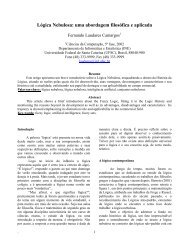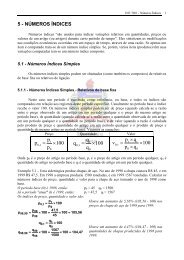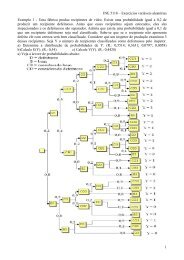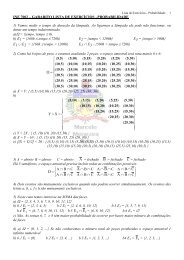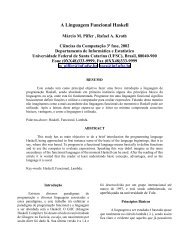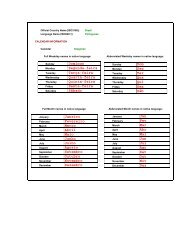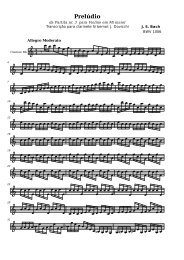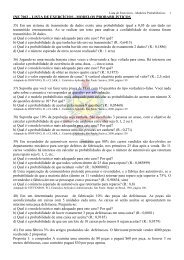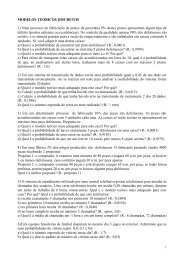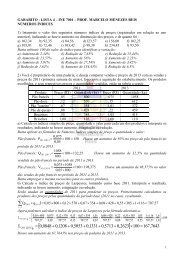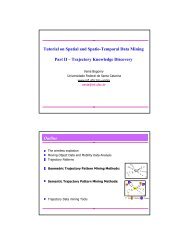Anais do IHC'2001 - Departamento de Informática e Estatística - UFSC
Anais do IHC'2001 - Departamento de Informática e Estatística - UFSC
Anais do IHC'2001 - Departamento de Informática e Estatística - UFSC
Create successful ePaper yourself
Turn your PDF publications into a flip-book with our unique Google optimized e-Paper software.
<strong>Anais</strong> <strong>do</strong> IHC’2001 - IV Workshop sobre Fatores Humanos em Sistemas Computacionais 37<br />
(<strong>de</strong> Souza, 1993). It views a computer system’s interface as a unique one-shot metamessage<br />
from <strong>de</strong>signer(s) to users. It is one-shot insofar as the <strong>de</strong>signer is no longer<br />
available for carrying out a genuine two-way conversation with users about the conveyed<br />
message. It is a meta-message, because it is itself capable of generating and exchanging<br />
with users a number of messages about the interaction, and which make up the interaction<br />
proper. It is also unique, because each computer application is built to solve particular<br />
problems of a given <strong>do</strong>main, following a specific <strong>de</strong>sign strategy, which cannot be found in<br />
its entirety in any other application.<br />
By investigating the characteristics of interaction in different environments, one of<br />
our goals is to analyze the advantages and disadvantages of having a single framework for<br />
analyzing (and <strong>de</strong>signing) interaction of a common range of services in different media and<br />
environments. In or<strong>de</strong>r to gui<strong>de</strong> our reflection about these issues, we present a case study,<br />
through which we have reached some interesting conclusions and further questions.<br />
In this paper, we apply linguistic studies of discourse structures and pragmatics to<br />
an analysis of HCI phenomena in multiple environments. We <strong>do</strong> so while a<strong>do</strong>pting the<br />
semiotic engineering theoretical framework as the basis for our work.<br />
In previous work (Dahis, 2001), we have <strong>de</strong>veloped a mo<strong>de</strong>l for representing<br />
interaction in such a way as to abstract <strong>de</strong>tails of specific interface styles and technological<br />
constraints, following an interaction-as-conversation paradigm (Brennan, 1990). This<br />
mo<strong>de</strong>l, however, did not explore some relevant aspects of discourse structure nor<br />
pragmatics. In this paper, we investigate how this mo<strong>de</strong>l, coupled with some studies about<br />
discourse structure (Gross & Sidner, 1986; Wachtel, 1986) and pragmatics (Leech, 1983),<br />
could be used to analyze interaction for a single set of services in different environments.<br />
2. Interaction Mo<strong>de</strong>l<br />
Dahis (2001) has proposed an interaction mo<strong>de</strong>l for representing interaction-asconversation.<br />
Her goal was to provi<strong>de</strong> a common mo<strong>de</strong>l for representing interaction at a<br />
high level of abstraction, which could be instantiated into different environments and<br />
interface styles. According to her, having a common interaction mo<strong>de</strong>l would facilitate the<br />
<strong>de</strong>sign and maintenance of these interfaces.<br />
Dahis’ mo<strong>de</strong>l was created to provi<strong>de</strong> a means for mo<strong>de</strong>ling interaction scenarios in<br />
a semi-formal representation. Her mo<strong>de</strong>l represents interaction at three levels of<br />
abstraction. From higher to lower levels, we have: tasks, dialogs, and utterances.<br />
A task in this mo<strong>de</strong>l represents how a real <strong>do</strong>main task may be accomplished using<br />
the system, i.e. a complete interaction scenario. It encompasses one or more dialogs (stages<br />
of interaction), which in turn are composed of utterances (units of interaction). She has<br />
classified all elements into semantic types at each level, and created possible mappings<br />
between levels. In or<strong>de</strong>r to <strong>do</strong> that, she <strong>de</strong>vised one or more templates of dialogs and<br />
corresponding utterances for any given dialog type. These templates were written in an<br />
interaction scenario specification language she has created, called LECI.<br />
A typical task specification in LECI would be:



